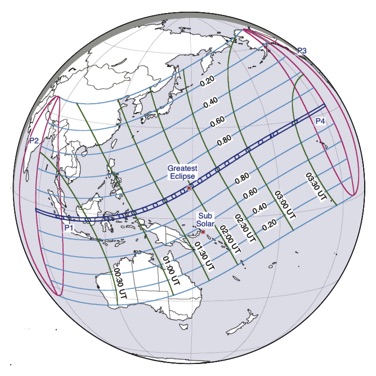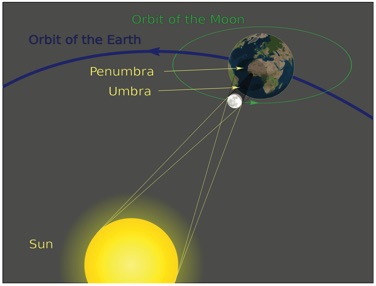The Moon will cast a dark shadow on the Earth when it passes directly between the Sun and the Earth. This blocking of the Sun’s light produces a phenomenon known as a solar eclipse. The view to the right in the main panel shows a total solar eclipse as seen from Sampit, Indonesia on March 9, 2016. During a total solar eclipse the Moon completely covers the Sun’s disk. The March 9, 2016 solar eclipse was the most recent total solar eclipse.
- Click here and press the Run Time Forward button to see the alignment between the Earth, the Moon, and the Sun during this eclipse.
- Click here and press the Run Time Forward button to see a ground’s eye view of this March 9 solar eclipse.
- Click here and press the Run Time Forward button to see a close-up view of the Moon slowly covering the Sun’s disk during the March 9 eclipse.
The dark, inner part of the shadow cast by the Moon on the Earth is known as the umbra. A person standing within the umbra will experience a total solar eclipse. The path of the umbra will slowly track eastward as the Earth rotates. This dark path that the umbra sweeps out as it travels over the surface of the Earth is known as the path of totality. Everyone standing within the path of totality will experience a total solar eclipse, a complete blocking of the Sun’s disk by the Moon. The outer part of the Moon’s shadow, where only some of the Sun’s light is blocked is known as the penumbra. Observers on the Earth in the penumbra shadow will see a partial solar eclipse.
- Click here to see a view of the umbra and penumbra shadow cones for the March 9 eclipse. Then press the Run Time Forward button to see the umbra travel across the Earth’s sphere.
One unique phenomenon that occurs at the beginning and end of a total solar eclipse is known as Bailey’s beads. Bailey’s beads refers to small slivers of sunlight, or beads, that are still visible around the Moon during a total solar eclipse. These “beads” are the result of light filtering through the irregular surface of the Moon as a result of topographical features like mountains, craters, and valleys. Another unique view, known as the diamond ring effect, is seen when only one bead is visible. Bailey’s beads are named in honor of Francis Bailey (1174 – 1844) who provided an explanation for these small slivers of light in 1836.
The recent total solar eclipse of March 9, 2016 spent most of its time over water, with only a small part of the path of totality covering land in Indonesia. The next total solar eclipse on August 21, 2017 will, however, be quite different.


